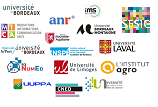ArgumentaireDistance Learning Systems, Platforms and Digital Environments: Where Do We Stand Today?
Expanding since the second half of the 20th century, open and distance learning (ODL) has emerged to meet the needs of specific audiences—whether “constrained” (due to disability, geographic isolation, etc.) or voluntary learners (those who prefer distance education). In France, it is available as early as primary school (mainly via the National Centre for Distance Education – CNED) and can continue through to the doctoral level, particularly in universities, as well as in continuing and lifelong education. Its deployment has been both politically driven and accelerated by the recent pandemic and related lockdowns. Initially developed as correspondence education, it now fully integrates digital technologies. This has led to the creation of socio-technical systems—spaces of mediation that facilitate access to online courses, assignment submission, learning progression, and more broadly, interaction, learning strategies, and learner agency. These are genuine platforms (Bullich, 2021), or even “platform-based systems” (Jeanneret, 2005), when considering both their material dimensions and their symbolic and info-communicational aspects. Investigating these platforms and systems also means examining their uses, practices, and mediations, without neglecting their functional, structural, normative, and symbolic underpinnings. It also raises questions about formal, non-formal, and informal learning in a context where high levels of autonomy are required to navigate one's educational path. Learners may supplement institutional resources with their own, adopt unique information-seeking practices, and engage in greater self-regulation—presumably more so than in face-to-face contexts. This symposium aims to take stock of the most recent research on distance learning systems and platforms, from both the learner’s perspective (uses and practices—informational, pedagogical, strategic...) and that of system design and experience (by comparing prescribed, perceived, planned and/or lived experiences [Paquelin, 2004], and examining their ergonomics and instructional design). Recognizing that such a complex object must be studied through multi- or even interdisciplinary approaches, the symposium welcomes contributions that address these systems and platforms from a variety of disciplinary perspectives (information and communication sciences, education, sociology, cognitive science, ergonomics, computer science...), focusing on material and symbolic dimensions, actors and interactions, including critical perspectives. The pedagogical transformation brought about by distance learning challenges learning practices, instructional models, learner persistence, and also the relationships between actors, their relationship to knowledge, forms of mediation and transition, as well as informational and learning practices. It also revives key questions around inclusion, academic success, accessibility, and innovation—particularly as ODL systems increasingly align with logics of massification, individualized pathways, rationalization, and sometimes humanization and resilience—or, conversely, dehumanization. Several thematic strands are proposed, without claiming to be exhaustive: Track 1 – Systems, Platforms, and Uses Track 2 – Shaping and Supporting Distance Learning Timespaces Track 3 – Engagement, Persistence, and Success in Distance Learning Track 4 – A Critical Perspective Submission GuidelinesA proposal of no more than 6,000 characters including spaces, accompanied by a short bibliography, should be submitted in French or English by October 17, 2025. A publication of the proceedings is planned (further information to follow). |


